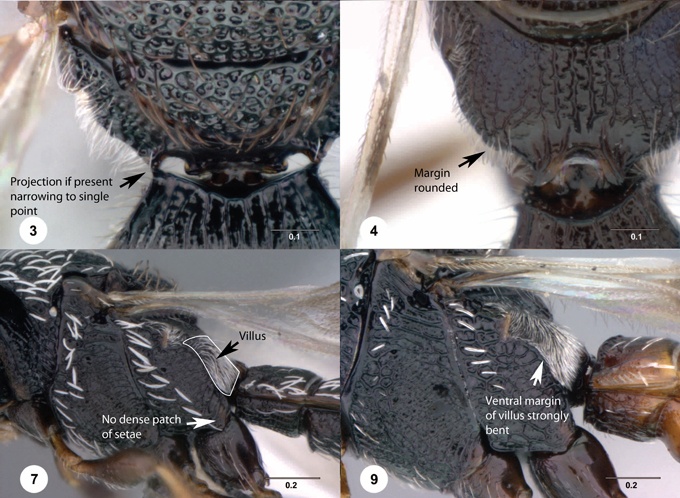
1.
Posterolateral propodeum rounded in dorsal view (best viewed with a
slightly oblique angle from the anterior, Fig 4), if propodeal projection present then narrowing to a single point ( Fig. 3) and without distinct inner and outer corners (as in Fig. 1); posteroventral portion of metapleuron never with a dense patch of
pilosity above hind coxa (Figs 7, 9); in lateral view ventral margin of villus
strongly bent such that posterior half nearly vertical (Figs 7,
9) ... 2
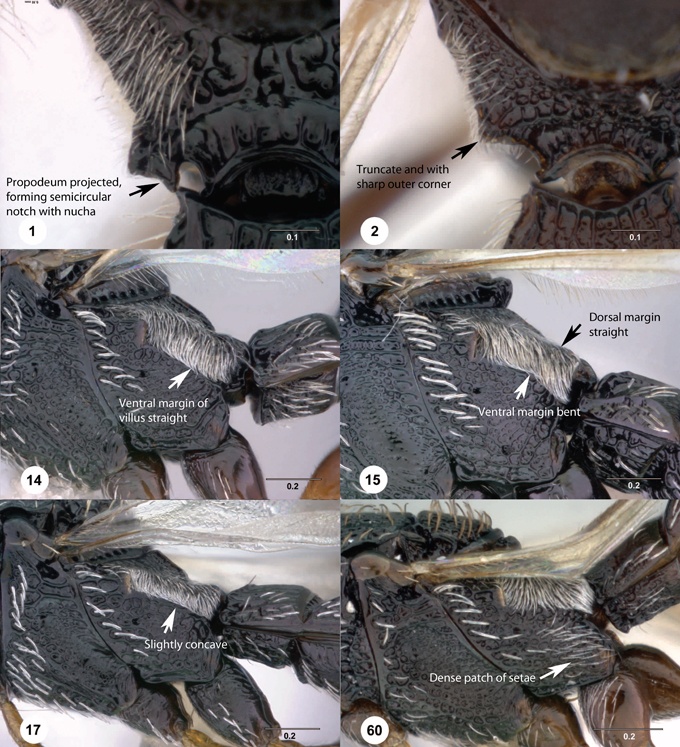
─
Posterior propodeum projected laterally and forming a semicircular notch
with nucha (Fig. 1), or truncate and with sharp outer corner (Fig. 2), or a dense patch of setae present above hind coxa on
posteroventral metapleuron (Fig. 60); in lateral view ventral
margin of villus variable in form: straight (Fig. 14) or
slightly concave (Fig. 17), if bent (Fig. 15) then
dorsal margin often straight ... 6
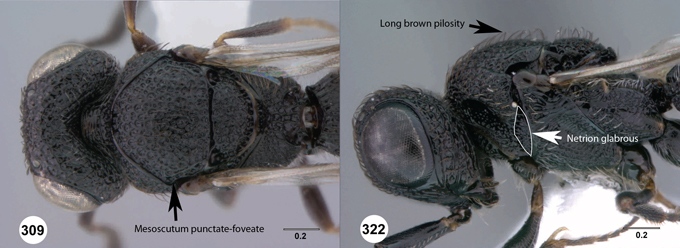
2.
Mesoscutum sculptured throughout with slightly flattened
rounded-reticulate sculpture that appears punctate-foveate in places
(Fig. 309); pilosity throughout mesonotum brown, fine, and
long (Fig. 322); netrion glabrous (Fig. 322) (anteclypeus coming to a
broad point medially; wings not pictate; male RSS present; South Africa,
Western Cape) ...simoni species group
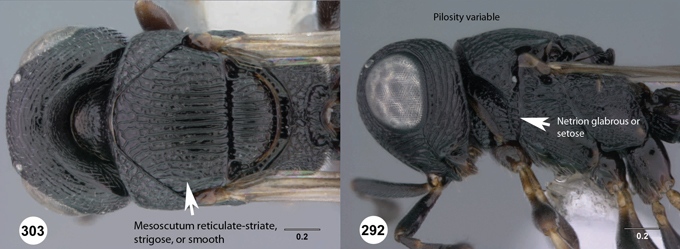
─
Mesoscutum variously sculptured, but never punctate-foveate throughout,
typically reticulate-striate or strigose, sometimes smooth; pilosity of
mesonotum variable, if long, fine and brown, then netrion setose;
netrion glabrous or setose ... 3
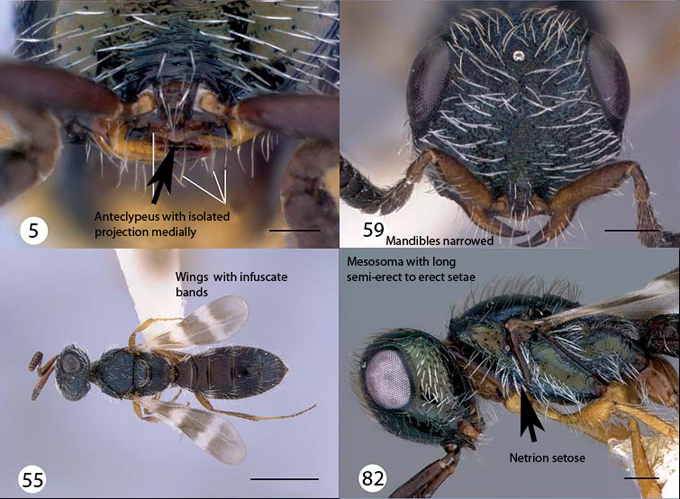
3.
Anteclypeus between medial teeth wide and slightly concave to truncate,
with isolated projection medially (Fig. 5), lateral projections well developed,
pointed, often oriented outwards; netrion setose (Fig. 82), pilosity reduced to
anterior margin in some; head and mesosoma sometimes with metallic
coloration (Fig. 82); mesosoma with long semi-erect to erect setae scattered
throughout (Fig. 82); females with wings pictate (infuscate bands) (Fig.
55); mandibles
narrowed (Fig. 59), often appearing unidentate but never truly so, with at least a
very reduced second tooth present (male A5 without RSS and nearly always
with hyaline/white wings) ...pulchripennis group species, see
Yoder et al. (2009b)
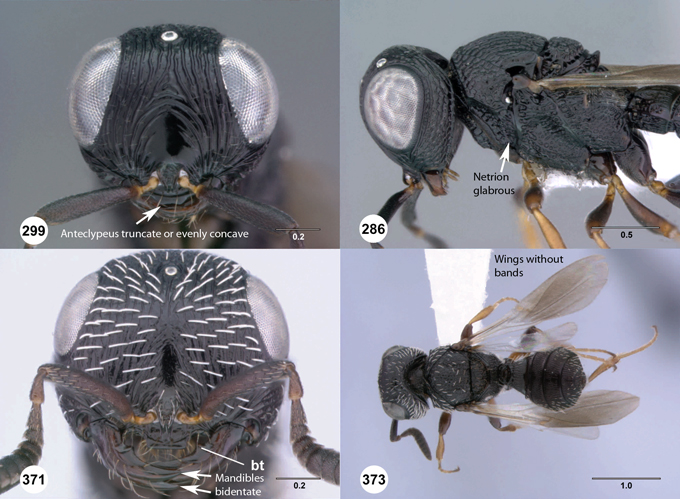
─
Anteclypeus between medial teeth projected and truncate or evenly
concave (Fig. 299), without a isolated projection medially, lateral projections
variously formed; netrion glabrous (Fig. 286); head and mesosoma never with
metallic coloration; mesosomal pilosity not elongate and erect; wings
without distinct bands, typically evenly infuscate throughout (Fig. 373); mandibles bidentate, teeth not reduced apically
(Fig. 371) ... 4
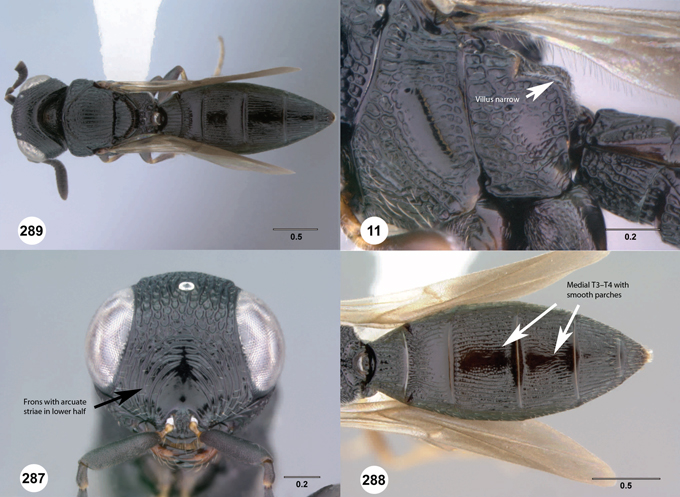
4.
Pilosity throughout very short, fine, sparse and appressed (Fig. 289); villus narrow, more or less equal width throughout
(Fig. 11); frons usually with percurrent arcuate striae in lower
half (Fig. 287); females with medial T3–T4 (Fig. 288)
and S2–S5 usually with smooth patches; (in lateral view gena broad,
somewhat flattened and with narrow occipital carina prominent;
Madagascar) ... irwini species group
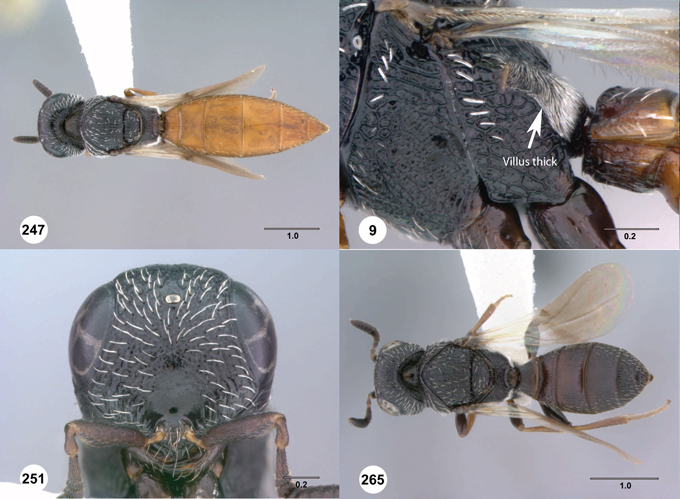
─
Pilosity moderate length, setae variable in width, but predominantly
thicker and moderately dense (Fig. 247); villus thick, broadening posteriorly (Fig. 9); frons rarely with percurrent arcuate striae in lower half,
sculpture usually interrupted medially, reticulate to rugulose (Fig. 251); females with medial T3–T4 usually sculptured,
medially S2–S5 variably sculptured or with smooth patch (Fig. 265); (continental
Africa, Madagascar) ... 5
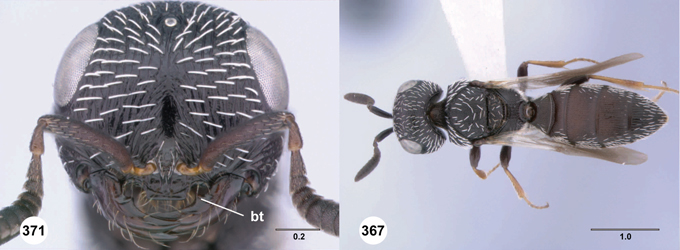
5. Basal
tooth on mandible present (Fig. 371, bt); metasoma dark brown to
black, concolorous with or very slightly lighter than mesosoma, never
orange or yellow; male RSS on A5 absent or apparently so; (body with at
least some setae that are thickened and most commonly white, or
uncommonly golden, or brown; thickened white pilosity typically present
on gena, pronotal shoulder and meso- and metapleural anterodorsal
margins, tips of pilosity truncated or not) ... walkeri
species group
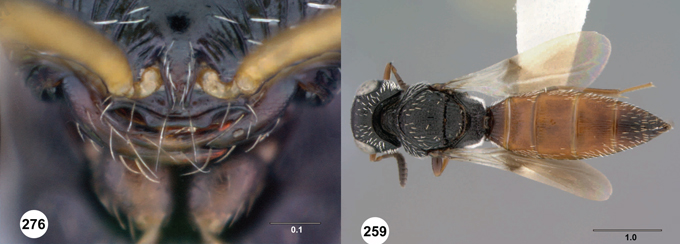
─ Basal
tooth on mandible nearly always absent (Fig. 276), if present then metasoma orange
(Fig 259);
metasoma orange (most species) to brown (a single species), never dark
brown to black, nearly always lighter than mesosoma; male RSS on A5
present ...ipomeae species group
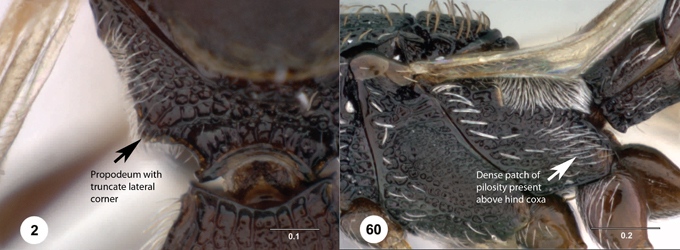
6.
Posterior propodeum with truncate lateral corner and no semicircular
notch (Fig. 2), or dense patch of pilosity present above hind coxa on
posteroventral metapleuron (Fig. 60) (most species with fine
reticulate sculpture at base of mandible) ... ernstii species
group
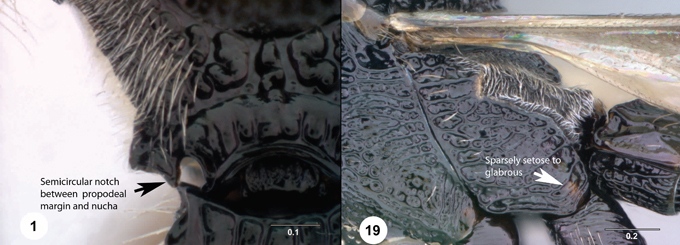
─
Posterior propodeum with a projection that forms a semicircular notch
between inner margin and propodeal nucha (Fig.1), posteroventral
metapleuron sparsely setose to glabrous (Fig. 19) ... howardi
species group
|